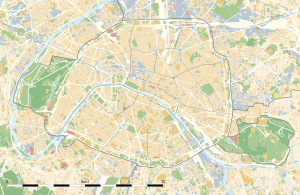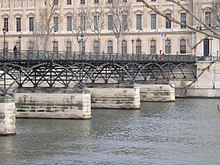Pont des Arts
Coordinates: 48 ° 51 ′ 30 ″ N , 2 ° 20 ′ 15 ″ E
| Pont des Arts | ||
|---|---|---|
| use | footbridge | |
| Crossing of | His | |
| place | Paris | |
| overall length | 155 m | |
| width | 11 m | |
| Number of openings | seven | |
| Longest span | 22 m | |
| completion | 1804/1852/1984 | |
| planner | de Cessart / Arretche | |
| location | ||
|
|
||
The Pont des Arts (German Bridge of the Arts ) is a pedestrian bridge over the Seine in Paris , connecting the Quai François-Mitterrand (formerly: Quai du Louvre) in the 1st arrondissement on the right bank with the Quai de Conti in the 6th arrondissement on the left Shore connects. It thus runs exactly on an axis between the center of the Cour Carrée des Louvre , the archway leading from it to the banks of the Seine and the Institut de France on the other side. It is the first bridge below the Île de la Cité and the Pont Neuf . The Pont du Carrousel follows the Pont des Arts downstream .
Bridge data
The current bridge, 155 meters long and 9.80 meters wide, consists of seven arches with a span of approx. 22 meters each . Its steel construction rests on six reinforced concrete bridge piers that are clad with natural stones. The bridge deck consists of beams made of hard West African azobe wood, placed at small intervals .
history
Bridge from 1804
The original Pont des Arts, also known as Passerelle des Arts ( Pedestrian Bridge of the Arts ), was built as a cast iron structure between 1802 and 1804 by his student Jacques Vincent de Lacroix Dillon based on a design by Louis-Alexandre de Cessart . It and the Pont d'Austerlitz , built around the same time, were the first cast-iron bridges in France. The bridge got its name from the neighboring Louvre , which was called Palais des Arts at the beginning of the 19th century because of its art collections . It had nine arches with spans of 17.34 m, each formed by five filigree arch supports, which were arranged parallel to each other at intervals of 2.4 m. Instead of elevating the bridge deck, which later became common, the gussets were spanned by small intermediate arches. A few horizontal and diagonal wrought iron struts stiffened the iron construction. On top of it lay wooden cross girders that carried the bearing beams of the wooden planking laid in the transverse direction. The construction costs were 787,655 francs and 65 centimes. On the day of the opening, 64,000 people flocked to the bridge to cross the Seine for the first time. Until the February Revolution of 1848, bridge tolls had to be paid for their crossing .
The bridge has always been reserved for pedestrians who could walk between the trees growing out of planters or relax on the chairs and benches of the bridge with a view of the eastern tip of the Île de la Cité or the Louvre. For a while there was even a greenhouse in the middle of the bridge.
Bridge from 1853/1876

In 1852, the then Italian star architect Louis Visconti (1791-1853), who was appointed by Emperor Napoléon III. had already been entrusted with the redesign of the Louvre, the contract to rebuild the Pont des Arts. On the occasion of the widening of the Quai de Conti, among other things, a bridge arch had to be demolished. The bridge now only consisted of eight bridge fields .
After Visconti's sudden death in 1853, his successor as chief architect of the new Louvre, Hector Martin Lefuel (1810–1881), also continued the renovation work on the bridge. In a second phase of reconstruction under Lefuel, the bridge was widened between 1871 and 1876.
This bridge was depicted as the main subject or in the background of their paintings by various painters of the 19th century.
Le Pont des Arts ( Pierre-Auguste Renoir , 1857)
Île de la Cité ( James McNeill Whistler , 1859)
Le Pont des Arts ( Stanislas Lépine , 1875)
Le Pont des Arts ( Paul Signac )
A Windy Day on the Pont des Arts ( Jean Béraud , 1880/1)
In 1918 the bridge was damaged by an aerial bomb. A ship collision in 1961 damaged five pillars, and another accident in 1973 damaged three pillars. In 1976, an inspection raised safety concerns about the stability of the bridge as a result of this damage. It was therefore banned in 1977. In 1979 a bridge pillar was rammed by a barge and the bridge collapsed over a width of 60 meters.
Bridge from 1984
From March 1982 to May 1984, the bridge was rebuilt under the direction of the architect Louis Arretche in the style of the previous bridge, but as a steel construction on concrete pillars that were clad with natural stone. In addition, the number of bridge fields has been reduced from eight to seven to facilitate navigation.
The Pont des Arts has been a listed building since 1975 .
Love locks
Today (especially on Valentine's Day) it is the custom of Parisians and tourists to seal their love with a lock that is attached to the iron fence of the bridge. The key is then thrown into the Seine. The city of Paris has the locks removed at irregular intervals because of the size. On June 8, 2014, a 2.4-meter-long section of the bridge railing collapsed under the weight of the many locks. In the meantime all locks have been removed. The railing was designed in such a way that it is no longer possible to attach locks.
Web links
- Insecula.com: "Pont des Arts" (en., Fr.)
- Pont des Arts - photos from today and from 1900
- Selfie instead of love locks ( Memento from August 12, 2014 in the Internet Archive ) (August 12, 2014)
Individual evidence
- ↑ Passerelle des Arts on the website of the former LCTC (now IFSTTAR)
- ^ Marcel Prade: Ponts & Viaducs au XIXe Siècle . Brissaud, Poitiers 1988. ISBN 2-902170-59-9 , p. 66
- ^ Richard J. Dietrich: Fascination Bridges. 2nd expanded edition, Callwey, Munich 2001, ISBN 3-7667-1511-9 , pp. 156–161
- ↑ The cast-iron arch truss bridges in France. In: Friedrich Heinzerling: The bridges in iron. Verlag von Otto Spamer, Leipzig 1870, p. 105 ( digitized on Google Books)
- ↑ Notice N ° PA00085998 on Base Mérimée
- ↑ Spiegel Online : Pont des Arts in Paris: part of the bridge collapses under the load of love locks , June 9, 2014, last accessed: June 9, 2014.











